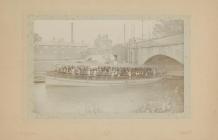Content can be downloaded for non-commercial purposes, such as for personal use or in educational resources.
For commercial purposes please contact the copyright holder directly.
Read more about the The Creative Archive Licence.
Description
Aberystwyth Railway Station was opened on 1 August 1864 as the terminus for the Aberystwyth & Welsh Coast Railway, later part of the Cambrian Railways.
From 12 August 1867 the Manchester & Milford Railway from Pencader Junction also used the station.
By 1872 the station consisted of two main platforms for the Cambrian line and a separate two-platformed bay for M&M trains.
Substantial alterations were made in 1893-4, but the major development came after the Cambrian was amalgamated with the Great Western Railway in 1922 (the M&M line had been operated by the GWR since 1906).
In 1924-5 a new station building fronting Alexandra Road and designed by Harris and Sheppard was erected. It is a classical two-storey, stepped 13-bay ashlar-fronted building with a parapet over a wide cornice and a plain entablature; there are three-bay end pavilions with Tuscan-derived end pilaster strips.
A truncated square clock tower to the east end has pedimented and pilastered frames to the four clock faces.
The platforms and covering canopies were considerably extended at the same time.
The station has contracted considerably since the 1960s: goods facilities were withdrawn and all sidings lifted; the signal box and goods shed were demolished and the site of the yard and carriage sidings sold for redevelopment. There is currently only one platform for main line trains, the former platforms on the east side also having been sold off.
The M&M closed in 1964 and since the 1968 season, the former 'Carmarthen' platforms have been occupied by the Vale of Rheidol Narrow Gauge Railway The large brick-built locomotive shed is currently occupied by the VoR, used currently as both a locomotive and carriage shed, although many other related features such as the coaling stage and water tower have been demolished.
The present passenger facilities occupy some of the 1872 buildings, including the ticket office range which was originally two railway houses, one for the Signalman, the other for the Stationmaster, backed by the platform and canopy of 1894.
Other remains of the 1872 station are still extant while the 1924-5 building has been converted to a public house.





Do you have information to add to this item? Please leave a comment
Comments (0)
You must be logged in to leave a comment